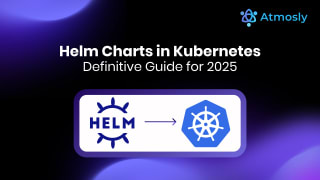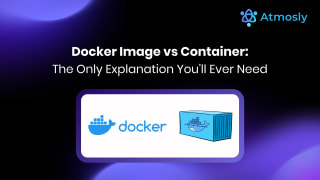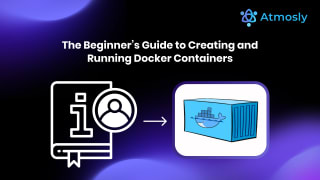Kubernetes has emerged as the de-facto standard for deploying and managing containerized applications at scale. For production workloads, AWS Elastic Kubernetes Service (EKS) offers a powerful managed Kubernetes solution. However, setting up a production-ready EKS cluster often involves intricate configurations, adherence to best practices, and significant time investment.
With Atmosly, this complexity is simplified. Atmosly's intuitive interface and infrastructure-as-code (IaC) automation enable you to spin up an AWS EKS production cluster in just 20 minutes while adhering to best practices. Let’s explore what makes a production cluster, why it’s critical, and how Atmosly streamlines the entire process.

What is a Production Cluster?
A production Kubernetes cluster is designed to run mission-critical applications that require:
- High Availability: Resilience against failure, ensuring minimal downtime.
- Scalability: Ability to handle increased workloads dynamically.
- Security: Strong identity, network, and data protection measures.
- Observability: Comprehensive monitoring for logs, metrics, and alerts.
- Compliance: Adherence to regulatory and organizational standards.
A production cluster differs from a development or testing environment due to the above requirements. Production environments are optimized for performance, reliability, and security to ensure business continuity.
How Atmosly Enables EKS Production Cluster Creation in 20 Minutes
Atmosly integrates automation, best practices, and intuitive workflows to minimize the time and effort required to create a production-ready EKS cluster.
1. Infrastructure as Code (IaC) Automation
Atmosly leverages IaC principles to define and provision EKS clusters programmatically. This approach ensures:
- Consistency: Eliminates manual configuration errors by automating setup processes.
- Reproducibility: Cluster configurations can be reused or replicated across multiple environments.
- Speed: Automated workflows provision resources in minutes rather than hours.
2. Bring Your Own VPC
When creating a cluster, Atmosly allows you to:
- Use an existing VPC or create a new one on the fly.
- Configure custom CIDR blocks and availability zones to optimize networking.
This ensures seamless integration with existing infrastructure while adhering to security and connectivity requirements.
3. Pre-Configured Production Settings
Atmosly incorporates AWS-recommended best practices for production:
- Multi-AZ Clusters: Deploys worker nodes across multiple availability zones for redundancy.
- Cluster Security Groups: Ensures secure communication between nodes, pods, and other AWS services.
- Private Endpoints: Restricts API server access to internal networks for enhanced security.
4. Add-Ons for Observability and Traffic Management
To ensure your cluster is production-ready, Atmosly allows you to enable add-ons such as:
- Prometheus and Grafana for performance monitoring.
- Loki for centralized log aggregation.
- NGINX Ingress Controller for managing application traffic.
- Cert Manager for automating TLS certificate management.
These add-ons are pre-integrated and can be enabled with just a few clicks, saving hours of configuration time.
Managing the Cluster for Day-to-Day Operations
Once your production cluster is live, Atmosly provides a range of features to simplify day-2 operations and optimize the management experience.
1. Node Group Management with Karpenter Integration
Node groups form the backbone of your EKS cluster, and Atmosly provides a robust set of tools for managing them efficiently. With its inbuilt support for Karpenter, Atmosly ensures seamless provisioning and scaling for both AWS-managed and Karpenter-managed node groups.

Key Features
- Node Group Creation and Scaling
- Define custom configurations for instance types, capacity types (on-demand or spot), disk sizes, and scaling parameters.
- Dynamically provision nodes based on workloads, leveraging Karpenter to automatically select the optimal EC2 instances based on resource demands (CPU, memory, etc.).
- Define custom configurations for instance types, capacity types (on-demand or spot), disk sizes, and scaling parameters.
- Real-Time Scaling with Karpenter
- Karpenter ensures real-time scaling by responding dynamically to workload changes, adding or removing nodes as needed.
- Automatically provisions resources to maintain performance during spikes while reducing underutilization during low-demand periods.
- Karpenter ensures real-time scaling by responding dynamically to workload changes, adding or removing nodes as needed.
- Cost Optimization
- Atmosly intelligently integrates Karpenter to optimize costs by selecting the most cost-effective instance types and utilizing spot instances when feasible.
- Enables efficient resource management by scaling up only when necessary and scaling down to avoid over-provisioning.
- Unified Node Group Support
- Offers flexibility to manage both AWS-managed node groups and Karpenter-managed node groups from a single interface, enabling teams to choose the provisioning approach that best suits their requirements.
- Offers flexibility to manage both AWS-managed node groups and Karpenter-managed node groups from a single interface, enabling teams to choose the provisioning approach that best suits their requirements.
- Node Health Monitoring
- View detailed metrics like CPU and memory usage to ensure nodes are optimally utilized.
- Analyze pod distribution across nodes to identify bottlenecks and maintain a balanced workload.
- Lifecycle Management
- Easily scale down, delete, or replace outdated nodes to ensure your cluster infrastructure remains current and efficient.
- Easily scale down, delete, or replace outdated nodes to ensure your cluster infrastructure remains current and efficient.

2. Kubernetes RBAC (Role-Based Access Control)
Atmosly simplifies permission management in Kubernetes with its intuitive RBAC interface, enhancing security and operational efficiency:
- Granular Role Assignments
- Define precise roles and permissions, restricting access to specific namespaces, resources, and actions to ensure security.
- Define precise roles and permissions, restricting access to specific namespaces, resources, and actions to ensure security.
- Time-Limited Access
- Grant temporary roles for short-term needs, with automatic revocation to minimize the risk of unauthorized access.
- Grant temporary roles for short-term needs, with automatic revocation to minimize the risk of unauthorized access.
- Streamlined Management
- Assign roles to users, service accounts, or groups effortlessly, eliminating the need for manual configurations.
- Assign roles to users, service accounts, or groups effortlessly, eliminating the need for manual configurations.
- Audit and Compliance
- Maintain detailed logs of role assignments for compliance audits, ensuring adherence to security standards.
With pre-configured policies and a user-friendly interface, Atmosly ensures efficient and secure access management for your clusters.

3. Cluster Upgrade Functionality
- Kubernetes Version Upgrades: Atmosly makes it effortless to upgrade your EKS cluster to the latest Kubernetes version. This ensures that your production cluster benefits from the latest security patches, performance improvements, and new Kubernetes features.
- Safe Upgrades: The platform follows AWS-recommended best practices to ensure upgrades are performed smoothly without disrupting workloads. Atmosly provides a step-by-step process for planning, upgrading, and validating cluster versions.
- Add-On Management: Atmosly enables CRUD (Create, Read, Update, Delete) operations for all integrated add-ons. Whether updating the Prometheus-Grafana-Loki Stack or configuring a new Ingress Controller, you can manage add-ons effortlessly through the Atmosly interface, eliminating the need for complex manual configurations.
4. Resource Visibility and Observability
Atmosly provides a centralized dashboard that offers comprehensive visibility into the health, performance, and operations of your Kubernetes clusters. By consolidating real-time metrics, logs, and insights, it enables efficient monitoring, troubleshooting, and compliance.
Key Features
- Pod Monitoring
- Track running pods, their resource consumption (CPU, memory), and restart counts.
- Quickly identify failing or underperforming pods to ensure application stability.
- Node Utilization and Performance
- Monitor resource usage (CPU, memory) across nodes to identify over or underutilized instances.
- Optimize workload distribution to maximize cost efficiency and performance.
- Detailed Cluster Logs
- Access a unified Cluster Logs Dashboard that records all cluster-related operations, including provisioning, scaling, upgrades, and add-on deployments.
- Logs are detailed and actionable, making it easier to identify root causes during troubleshooting and ensure operational transparency.
- Infrastructure-as-Code (IaC) Transparency
- Every operation is implemented via IaC, ensuring all changes are auditable, repeatable, and consistent.
- Prevents configuration drift by providing a single source of truth for all cluster activities.
- Simplified Troubleshooting
- The Cluster Logs offer insights into past and ongoing operations, enabling teams to resolve issues efficiently.
- Track specific events, such as node provisioning errors or add-on upgrade failures, to take corrective action promptly.
- Compliance and Auditing
- The comprehensive visibility provided by Atmosly ensures your operations adhere to industry standards.
- Simplifies audits by maintaining a detailed record of changes, deployments, and configurations, making it easy to demonstrate accountability.
By combining real-time monitoring, historical logging, and robust observability tools, Atmosly ensures your clusters are optimized, compliant, and ready to handle the demands of production workloads.
5. Built-In Cost Optimization
Atmosly helps manage production costs effectively with smart automation and resource insights:
- Automated Start/Stop for Non-Production Environments
- Automatically schedules non-critical environments, like QA or staging, to shut down during off-hours, significantly reducing idle resource costs.
- Automatically schedules non-critical environments, like QA or staging, to shut down during off-hours, significantly reducing idle resource costs.
- Spot Instance Integration
- Leverages cost-efficient spot instances for non-critical workloads, reducing compute costs by up to 90%.
- Includes fallback mechanisms to switch to on-demand instances, ensuring availability during interruptions.
- Resource Utilization and Cost Insights
- Provides detailed metrics on resource usage, helping identify underutilized nodes or pods.
- Offers cost breakdowns, enabling informed decisions to optimize scaling and workload distribution.
With these features, Atmosly ensures cost efficiency without compromising cluster performance or reliability.

Day-2 Operations: Ensuring Stability and Scalability
Scaling and Auto-Healing
Production clusters must handle unexpected traffic spikes and failures seamlessly. Atmosly supports:
- Horizontal Scaling: Automatically adds nodes or pods when demand increases.
- Self-Healing: Automatically replaces unhealthy nodes or restarts failing pods.
Security and Compliance
Atmosly integrates security best practices throughout the cluster lifecycle:
- Integrated DevSecOps Pipelines: Automates vulnerability scans for container images and code.
- IAM Integration: Ensures secure access to AWS resources.
- Network Policies: Restricts pod-to-pod communication to prevent unauthorized access.

Application Traffic Management
For production-grade workloads, managing external and internal traffic is critical:
- NGINX Ingress Controller: Routes external traffic securely.
- Load Balancers: Automates provisioning of ALBs/ELBs to distribute traffic efficiently.
- Custom DNS Integration: Seamlessly integrates with Route 53 for custom domain configurations.

Production Cluster Use Cases
Atmosly’s EKS production clusters are tailored to support various use cases:
- SaaS Applications: Scalable, secure, and compliant environments for delivering cloud applications.
- Data-Intensive Workloads: Handle big data processing with optimized resources and scaling.
- Microservices Deployments: Simplify the deployment of distributed microservices with seamless orchestration.
- CI/CD Pipelines: Integrated pipelines for automated deployments and rollback capabilities.
Why Atmosly ?
- Time Efficiency: Launch production-grade clusters in minutes, not hours.
- Built-In Best Practices: Adherence to AWS-recommended configurations for security and availability.
- Enhanced Observability: Pre-integrated tools for monitoring and log aggregation.
- Streamlined Management: Simplified workflows for day-to-day operations.
- Cost Optimization: Advanced features to reduce cloud expenditure.
Conclusion
Building a production-ready Kubernetes cluster on AWS EKS can be a daunting task, but Atmosly transforms this process into a seamless experience. With features like IaC automation, pre-configured best practices, and robust tools for day-2 operations, Atmosly empowers DevOps teams to focus on innovation rather than infrastructure management.
Whether you're launching a new SaaS application or optimizing a legacy workload, Atmosly ensures your production environment is ready to meet your business needs—quickly, securely, and efficiently.
Start your journey toward efficient Kubernetes management today. Book a Demo and see how Atmosly can help you create and manage your AWS EKS production clusters in just 20 minutes.






